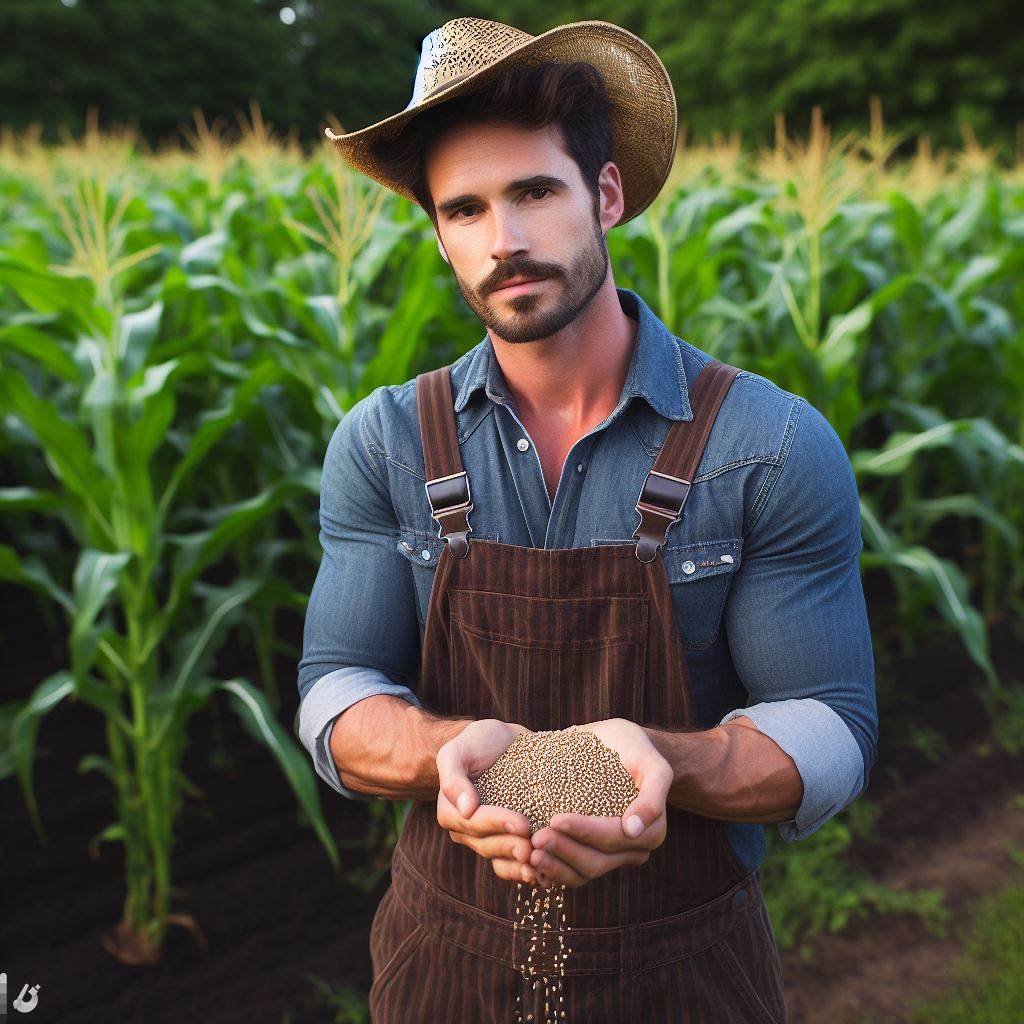Introduction
Let’s explore pest control in corn fields: Effective strategies.
Pest control in corn fields plays a crucial role in ensuring successful cultivation.
This blog post aims to discuss effective strategies for pest control in corn fields.
Pest control is vital in corn fields because it helps minimize crop damage caused by pests.
Corn is susceptible to various pests, including insects, rodents, and weeds, which can reduce yield and profits.
The purpose of this blog post is to provide farmers and agricultural enthusiasts with valuable insights into effective strategies for pest control in corn fields.
By implementing these strategies, farmers can protect their crops and maximize productivity.
Now let’s delve into some effective strategies for pest control in corn fields.
Common pests in corn fields
List of pests commonly found in corn fields
Cornfields are susceptible to various pests that can cause significant damage to the crops.
Here is a list of common pests that farmers encounter:
- Corn borers: These pests are notorious for tunneling into the cornstalks, weakening them and making them susceptible to diseases and breakage.
- Corn earworms: Also known as the Helicoverpa zea, these caterpillars feast on corn ears, causing kernel damage and reducing crop yield.
- Corn rootworms: These pests feed on corn plant roots, leading to stunted growth, reduced nutrient absorption, and overall weakened plants.
- Corn leaf aphids: These tiny insects thrive on corn leaves, sucking sap and transmitting viruses that can affect the entire plant.
- Common armyworms: These voracious caterpillars can quickly strip corn leaves, leaving behind skeletonized plants and reducing photosynthesis.
Description of the damage caused by each pest
- Corn borers: The presence of corn borers can result in plants with wilted leaves, stalk breakage, and an increased susceptibility to fungal and bacterial diseases. This pest can reduce overall yield and quality of the corn crop significantly.
- Corn earworms: Corn earworms cause damage by tunneling into the corn ears, feeding on the kernels. This leads to significant yield loss and also increases the risk of fungal infections.
- Corn rootworms: Corn rootworms damage the plant by feeding on the roots, which weakens the plant’s anchorage and ability to absorb water and nutrients. This can lead to reduced yield and plant lodging.
- Corn leaf aphids: The primary damage caused by corn leaf aphids is the depletion of sap from corn leaves, resulting in yellowing leaves, stunted growth, and reduced photosynthesis.
Aphids are also vectors for viral diseases that can cause further damage to the crop. - Common armyworms: Common armyworms are notorious for defoliating corn plants rapidly. They consume corn leaves, leaving only skeletal remains.
This reduces the plant’s ability to capture sunlight for photosynthesis, leading to stunted growth and reduced yield.
Dealing with these pests requires effective pest control strategies, combining both preventive and reactive measures.
Farmers must be proactive in implementing comprehensive pest management plans to minimize the impact of these pests on their corn fields.
Preventive measures include the following
- Crop rotation: Avoid continuous planting of corn in the same field as this can attract and sustain pests. Rotate corn with other crops such as soybeans or wheat to break the pests’ life cycle.
- Trap crops: Planting specific crops that attract pests away from the main cornfield can provide a sacrificial area for pests to concentrate, reducing damage to the main crop.
- Field hygiene: Regularly remove crop residue and weed plants, preventing pests from finding shelter and breeding sites in the field.
Reactive measures for pest control include
- Biological control: Introduce natural predators or parasites, such as wasps or nematodes, that feed on or infect the pests, reducing their populations.
- Chemical control: Use insecticides specifically formulated for effective pest control in corn fields. Target the pests during their vulnerable stages, taking precautions to minimize environmental impact.
- Trapping and monitoring: Set up pheromone traps to monitor pest populations and assess the need for further action. Early detection allows for timely intervention.
Maintaining a balance between pest control and environmental sustainability is crucial.
By understanding the common pests in corn fields and implementing appropriate strategies, farmers can effectively protect their crops and maximize their yields.
Read: Mastering Palm Kernel Farming: A Complete Process Guide
Transform Your Agribusiness
Unlock your farm's potential with expert advice tailored to your needs. Get actionable steps that drive real results.
Get StartedPrevention and cultural practices
Effective pest control in corn fields requires a proactive approach that focuses on prevention and cultural practices.
By implementing the following strategies, farmers can minimize the reliance on chemical pesticides and promote a healthier, more sustainable ecosystem.
Crop rotation and diverse planting
Crop rotation and diverse planting play a crucial role in pest management.
Rotating crops disrupts pest life cycles and reduces the buildup of pests in the soil.
Planting a variety of crops creates a less favorable environment for pests, as they struggle to find their preferred host plants.
Avoiding consecutive planting of the same crop is essential to minimize pest infestation.
Proper field preparation and seed selection
Proper field preparation and seed selection are vital steps in preventing pest outbreaks.
Clearing the field of debris and residues eliminates potential pest habitats.
Using clean and disease-free seeds ensures that pests are not introduced into the field from the beginning.
Selecting naturally resistant seed varieties reduces the need for chemical interventions.
Monitoring and scouting for pests
Regular monitoring and scouting for pests are crucial for early pest detection.
Farmers should regularly inspect crops for signs of pest damage, such as chewed leaves or wilting plants.
Implementing a systematic scouting process, including the use of traps and pheromone lures, helps to monitor pest populations and better understand their behavior.
Keeping records of pest activity allows farmers to evaluate trend patterns and make informed decisions for future management practices.
Weed control
Weed control is closely intertwined with pest control.
Weeds can act as alternate hosts for pests, providing them with food and shelter.
Removing weeds and implementing mechanical and manual weed control methods helps minimize pest habitats.
Mulching and regular cultivation can also prevent weed growth and reduce competition for resources, ensuring healthier crops.
While chemical options exist, they should only be used as a last resort.
By adopting preventative strategies and cultural practices, farmers can minimize the need for chemical pesticides, reducing their environmental impact and promoting sustainable pest control in corn fields.
In essence, prevention and cultural practices are essential components of effective pest control in corn fields.
Crop rotation, diverse planting, proper field preparation, seed selection, monitoring, scouting, and weed control all contribute to a healthier and more sustainable pest management approach.
By implementing these strategies, farmers can reduce reliance on chemical pesticides while maintaining productive and thriving corn crops.
Read: Sustainable Tech in Agriculture: A New Era
Showcase Your Farming Business
Publish your professional farming services profile on our blog for a one-time fee of $200 and reach a dedicated audience of farmers and agribusiness owners.
Publish Your ProfileBiological pest control methods
Introduction to biological control
Biological pest control methods focus on utilizing natural enemies of pests to control their population.
This approach is safe and sustainable, with minimal environmental impacts.
By emulating natural ecosystems, farmers can reduce the need for chemical pesticides and promote a balanced ecosystem within their corn fields.
Implementation of beneficial insects and organisms
One effective strategy for biological pest control in corn fields is the introduction of beneficial insects and organisms.
These natural predators feed on the pests, keeping their population in check.
Ladybugs, lacewings, and parasitic wasps are commonly used insects that prey on pests like aphids, caterpillars, and mites.
By releasing these beneficial insects at strategic times, farmers can reduce pest damage and decrease reliance on synthetic pesticides.
Use of trap crops
Another approach to biological pest control is the use of trap crops.
These crops are planted near the main corn fields to attract pests away from the primary crop.
Trap crops serve as a sacrificial bait, luring pests and drawing them away from the corn plants.
By strategically selecting trap crops that pests find irresistible, farmers can protect their corn fields and minimize the need for chemical control.
Conservation and enhancement of natural enemies
Conserving and enhancing natural enemies of pests is an essential aspect of biological pest control.
By providing suitable habitats and food sources for these beneficial organisms, farmers can encourage their populations to thrive.
Planting diverse flowering plants and maintaining hedgerows can attract and sustain natural enemies like birds, spiders, and beneficial insects.
These organisms prey on pests and help maintain ecological balance in the corn fields.
Enhancing biodiversity and ecosystem services should be an integral part of pest management strategies in corn fields.
A healthy and diverse ecosystem acts as a natural defense against pests, reducing the need for external interventions.
Farmers can achieve this by avoiding the use of broad-spectrum pesticides and adopting integrated pest management practices.
In review, biological pest control methods offer effective and sustainable strategies for managing pests in corn fields.
By introducing beneficial insects, using trap crops, and conserving natural enemies, farmers can reduce the impact of pests without relying heavily on chemical pesticides.
This approach not only protects the environment but also ensures long-term productivity and profitability in corn farming.
By embracing biological pest control, farmers can contribute to a healthier and more sustainable agricultural system.
Read: Best Soil Types for Growing Wheat: An Overview

Chemical pest control methods
Overview of chemical pesticides
Chemical pesticides are commonly used in corn fields to control pests effectively.
These pesticides work by targeting and eliminating pests that damage corn crops.
There are different types of chemical pesticides available, including insecticides, herbicides, and fungicides.
Insecticides specifically target and kill insects that feed on corn plants, preventing damage to the crops.
Herbicides, on the other hand, are used to control weeds that compete with corn for nutrients and resources.
Fungicides are used to protect corn plants from fungal diseases, which can greatly reduce yields.
Selecting and applying insecticides effectively
Selecting the right insecticide is crucial for effective pest control in corn fields.
Farmers should consider the specific pests they are dealing with and choose insecticides that target those pests.
It is important to read and follow the label instructions when applying insecticides.
Applying the correct dosage at the right time ensures maximum effectiveness and minimizes the risk of resistance development.
Spraying insecticides evenly and thoroughly across the corn field helps reach all areas where pests may be present.
Farmers should also consider the weather conditions and choose the appropriate time for spraying to optimize effectiveness.
Safety precautions and environmental concerns
While chemical pesticides can be effective, it is important to use them safely to protect human health and the environment.
Farmers should wear appropriate protective clothing, such as gloves and masks, when handling and applying pesticides.
They should also follow proper storage and disposal practices to prevent contamination of water sources and soil.
It is essential to adhere to recommended pre-harvest intervals to ensure that pesticide residues do not exceed safety levels in harvested corn.
Integrated Pest Management (IPM) practices should be followed to minimize reliance on chemical pesticides.
Showcase Your Farming Business
Publish your professional farming services profile on our blog for a one-time fee of $200 and reach a dedicated audience of farmers and agribusiness owners.
Publish Your ProfileThis includes using preventative measures, such as crop rotation and maintaining healthy soil, to reduce the need for pesticides.
In brief, chemical pest control methods, particularly the use of insecticides, are crucial for effective pest management in corn fields.
By selecting and applying insecticides correctly, farmers can protect their crops from damaging insects and optimize yields.
However, it is essential to prioritize safety precautions and consider environmental concerns when using chemical pesticides.
Integrated Pest Management practices should be incorporated to minimize reliance on chemicals and promote sustainable pest control strategies.
Read: Tomato Cultivation: Tips for a Healthy Crop
Integrated Pest Management (IPM)
Definition and Principles of IPM
Integrated Pest Management (IPM) is a comprehensive approach to pest control that focuses on utilizing a combination of strategies to manage pests effectively.
It incorporates various techniques and principles to minimize the use of chemical pesticides and promote sustainable agriculture.
- IPM aims to prevent pest population growth and damage without causing harm to humans and the environment.
- It utilizes a combination of biological, cultural, physical, and chemical control methods.
- The principles of IPM include monitoring, prevention, intervention, and evaluation.
- Proper identification and monitoring of pests are essential for effective IPM implementation.
Importance of Incorporating All Pest Control Methods
Incorporating all pest control methods is crucial in IPM to achieve long-term pest management and reduce pesticide reliance.
Each control method serves a specific purpose in the overall pest control strategy.
- Biological control involves the use of natural enemies like predators, parasites, and pathogens to regulate pest populations.
- Cultural control focuses on modifying the crop environment through practices like crop rotation, planting resistant varieties, and adjusting planting dates to make it less favorable for pests.
- Physical control includes the use of barriers, traps, and mechanical methods to physically prevent pests from damaging the crops.
- Chemical control, although minimized in IPM, may be necessary when other methods are insufficient. It involves the targeted and judicious use of pesticides.
Steps for Implementing IPM in Corn Fields
Implementing IPM in corn fields requires a systematic and well-planned approach.
The following steps are crucial for successful implementation:
- Pest Identification: Properly identify the pests that pose a threat to corn crops. This helps in determining the appropriate control methods.
- Monitoring: Regularly monitor pest populations and crop health to detect early signs of infestation and take appropriate actions.
- Threshold Levels: Establish threshold levels, which determine the pest population size at which action should be taken to prevent yield loss.
- Prevention: Implement preventive measures like crop rotation, habitat modification, and sanitation practices to minimize pest infestation.
- Intervention: When pest populations exceed threshold levels, consider using non-chemical control methods such as biological control and physical barriers.
- Pesticide Application: If necessary, apply pesticides judiciously following label instructions, keeping in mind their potential impact on non-target organisms.
- Evaluation: Regularly evaluate the effectiveness of IPM strategies and make necessary adjustments to achieve better pest control outcomes.
By following these steps, farmers can implement IPM successfully in corn fields, which leads to improved pest control and reduced environmental impact.
In a nutshell, Integrated Pest Management (IPM) is an effective approach to pest control in corn fields.
It emphasizes the use of multiple strategies to minimize pest damage while reducing reliance on harmful chemical pesticides.
By incorporating all pest control methods and following a systematic approach, farmers can achieve sustainable and long-term pest management in their corn crops.
Read: Automated Tractors: The Future of Ploughing
Case studies and success stories
Successful pest control strategies in corn fields
- Crop rotation: By alternating corn with other crops, farmers can disrupt pest cycles and reduce infestations.
- Biological control: Introducing natural predators such as ladybugs or parasitic wasps can help control pests without the use of chemicals.
- Integrated Pest Management (IPM): This approach combines various pest control strategies to minimize chemical use and enhance sustainability.
- Trap crops: Planting specific crops that attract pests away from the main corn fields can divert their attention and reduce damage.
- Genetic resistance: Utilizing genetically modified corn varieties that are resistant to certain pests can significantly reduce the need for pesticides.
Examples of farmers who have implemented effective strategies
- John Smith, a corn farmer in Iowa, successfully implemented crop rotation on his farm. By alternating corn with soybeans and wheat, he managed to reduce corn rootworm populations and enhance overall crop health.
- Sarah Johnson, a farmer in Nebraska, adopted biological control methods by releasing ladybugs and lacewings into her corn fields. This helped control aphid populations and kept her crops healthy without the need for chemical pesticides.
- Mark Thompson, a farmer in Illinois, implemented an IPM approach on his farm. By regularly monitoring pest populations, using pheromone traps, and employing biological control methods, he achieved effective pest control while minimizing the use of synthetic pesticides.
- Michael Peterson, a farmer in Minnesota, successfully used trap crops to control corn earworms. He planted sunflowers around his corn fields, attracting the pests away from the main crop and reducing damage.
- Emily Davis, a farmer in Indiana, opted for genetically modified corn varieties that were resistant to European corn borers. This allowed her to drastically reduce the use of insecticides, saving costs and minimizing environmental impact.
All in all, there are several successful pest control strategies in corn fields that farmers can employ.
Crop rotation, biological control, IPM, trap crops, and genetic resistance all contribute to effective pest management.
By learning from case studies and success stories, farmers can implement these strategies to protect their corn crops and enhance sustainability in agriculture.
Conclusion
Pest control is of utmost importance in corn fields to ensure a successful harvest. Pests can cause significant damage to crops, resulting in lower yields and financial losses for farmers.
By implementing effective pest control strategies, such as crop rotation, biological control methods, and the judicious use of pesticides, farmers can minimize the impact of pests on their corn fields.
It is crucial for farmers to understand the importance of regular monitoring and early detection of pests, as well as the importance of implementing integrated pest management techniques for long-term sustainability.
Therefore, I strongly encourage farmers to educate themselves about the different pests that can affect corn crops and stay updated on the latest research and best practices in pest control.
Investing in pest control measures and adopting sustainable farming practices will not only protect their crops but also contribute to the overall health of the environment and the well-being of consumers.
Let us all take action to protect our corn fields from pests and ensure a healthy and thriving agricultural industry for generations to come.




